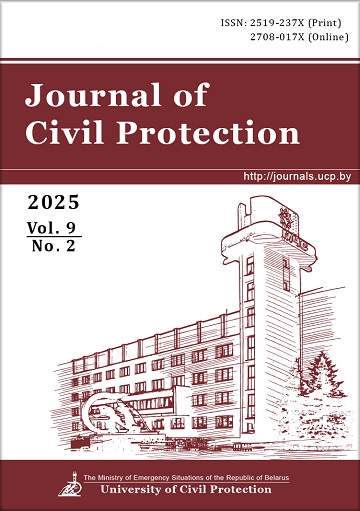Film-forming fire extinguishing chemical composition for automatic fire extinguishing systems, supplied by spraying
DOI:
https://doi.org/10.33408/2519-237X.2025.9-2.167Keywords:
surfactants, surface tension coefficient, interfacial tension coefficient, full factorial experiment, mathematical model, foaming agentAbstract
Purpose. Development of a universal film-forming fire extinguishing chemical composition for fire extinguishing systems and water foam based on fluorinated surfactants for extinguishing class A and B fires (combustion of solid and liquid flammable substances), supplied for extinguishing by spraying.
Methods. Empirical research methods (measurement of surface and interfacial tension of solutions), the method of randomization and full factorial experiment to obtain regression models, as well as the «Desirability Profiles» module of the STATISTICA software package. The determination of the coefficients of surface and interfacial tension of solutions of surfactants in aqueous systems was carried out by the method of tearing off the Du Nouy ring on an automatic tensiometer KRÜSS-K20.
Findings. The choice of components of the film-forming fire extinguishing chemical composition is substantiated: fluorinated surfactants (FS), hydrocarbon surfactants (HS) and a co-solvent. The results of a full factorial experiment are presented, on the basis of which regression models were obtained that describe the change in the value of the coefficient of spreading of the water film on the surface of the flammable liquid, interfacial tension coefficient, wetting time of a cotton fabric sample, the time of existence of the water film on the surface of the flammable liquid, the thickness of the water film on the surface of the flammable liquid and the extinguishing time of a model Class B fire depending on the ratio of the components of the film-forming fire extinguishing chemical compositions. From the established dependences of the extinguishing time of model fires on the mass fraction of the components of the film-forming fire extinguishing composition, the range of interfacial tension of 1.7–1.9 mN·m⁻¹ and the spreading coefficient of 3.0–3.2 mN·m⁻¹ were determined, at which the fire extinguishing efficiency of the film-forming fire extinguishing composition is maximum and makes 55 s, which is 35 % higher than the fire extinguishing efficiency of commercially available film-forming foaming agents. Based on the established dependencies of the extinguishing time of model fires on the coefficient of interfacial tension of aqueous solutions of FS, HS with a co-solvent, a formulation of a film-forming fire extinguishing composition has been developed, consisting of 2.9±0.1 wt.% amphoteric FS, 1.5±0.1 wt.% nonionic HS, 3.0±0.1 wt.% anionic HS, 10.0±0.1 wt.% organic solvent and 82.9±0.1 wt.% water, which differs from the investigated compositions and existing analogues by the greatest fire extinguishing efficiency when applied by spraying.
Application field of research. The obtained results can be used in developing the formulation of film-forming fire extinguishing compositions for extinguishing fires.
References
Goncharenko V.S., Chechetina T.A., Sibirko V.I. [et al.]. Pozhary i pozharnaya bezopasnost' v 2023 godu [Fires and fire safety in 2023]: information and analytical compendium. Balashiha: FGBU VNIIPO EMERCOM of Russia, 2024. 110 p. (rus). EDN: https://elibrary.ru/BSONFO.
Cong B.H., Liao G.X., Huang Z. Extinguishment of liquid fuel fires by water mist with additives. Proc. of the Asia-Oceania Symposium on Fire Science & Technology (AOFST 7), 2007. Aticle 95. 11 p. Available at: https://publications.iafss.org/publications/aofst/7/95 (accessed: March 3, 2025).
Wu B., Liao G. Experimental study on fire extinguishing of water mist with a newly prepared multi-component additive. Procedia Engineering, 2013. Vol. 62. Pp. 317–323. DOI: https://doi.org/10.1016/j.proeng.2013.08.070.
Kim A.K., Dlugogorski B.Z., Mawhinney J.R. The effect of foam additives on the fire suppression efficiency of water mist. National Fire Laboratory, Institute for Research in Construction, National Research Council Canada, Ottawa, Canada, 1994. 12 p. Available at: https://www.nist.gov/system/files/documents/el/fire_research/R9402226.pdf (accessed: March 3, 2025).
Speranskiy A.A., Mamagin S.V., Pavlov D.I. Opredeleniye ognetushashchey effektivnosti opytnogo obraztsa sudovoy sistemy pozharotusheniya s ispol'zovaniyem tonkoraspylennoy vody dlya zashchity mashinnykh i mashinno-kotel'nykh otdeleniy [Determination of fire extinguishing efficiency of the experimental sample of ship system of fire-fighting with use of thin open water for protection machine and machine-boiler departments]. Modern Problems of Civil Protection, 2018. No. 2 (27). Pp. 40–44. (rus). EDN: https://elibrary.ru/XWXQAX.
Tatem P.A., Beyler C.L., DiNenno P.J., Budnick E.K., Back G.G., Younis S.E. A review of water mist technology for fire suppression. Naval Research Laboratory, Washington, 1994. 93 p. Registration No. NAL/MR/6180-94-7624. Available at: https://www.researchgate.net/publication/235097941_A_Review_of_Water_Mist_Technology_for_Fire_Suppression (accessed: March 3, 2025).
Bobkov S.A., Baburin A.V., Komrakov P.V. Fiziko-khimicheskiye osnovy razvitiya i tusheniya pozharov [Physico-chemical bases of fire development and suppression]: tutorial. Moscow: State Fire Academy of EMERCOM of Russia, 2014. 210 p. (rus)
Sharovarnikov A.F., Sharovarnikov S.A. Penoobrazovateli i peny dlya tusheniya pozharov. Sostav, svoystva, primeneniye [Foaming agents and foams for fire extinguishing. Composition, properties, application]. Moscow: Pozhnauka, 2005. 335 p. (rus). EDN: https://elibrary.ru/UWCCSP.
Ivanov I.Yu., Kondakova Ya.A., Navrotskiy O.D. Obzor osnovnykh kharakteristik plenkoobrazuyushchikh penoobrazovateley i sposoby ikh kontrolya [Overview of the main characteristics of film-forming blowing agents and how to control them]. Proc. of V Intern. scientific-practical conf. «Sovremennye pozharobezopasnye materialy i tekhnologii», Ivanovo, October 14, 2021. Ivanovo: Ivanovo Fire Rescue Academy of the State Fire Service of EMERCOM of Russia, 2021. Pp. 41–47. (rus). EDN: https://elibrary.ru/PATKDW.
Ivanov I.Yu., Navrotskiy O.D., Kondakova Ya.A., Krasavin V.E., Busel M.O. Issledovanie ftorirovannykh poverkhnostno-aktivnykh veshchestv dlya razrabotki plenkoobrazuyushchego ognetushashchego sostava [Research of fluorinated surfactants for the development of a film-forming fire extinguishing composition]. Journal of Civil Protection, 2022. Vol. 6, No. 4. Pp. 415–428. (rus). DOI: https://doi.org/10.33408/2519-237X.2022.6-4.415. EDN: https://elibrary.ru/DGPXST.
Ivanov I.Yu., Navrotskiy O.D., Likhomanov A.O., Zhurov M.M. Regressionnaya model' prognozirovaniya koeffitsienta rastekaniya plenkoobrazuyushchikh ogne-tushashchikh sostavov po poverkhnosti goryuchey zhidkosti ot sootnosheniya ikh komponentov [Regression model for predicting the effectiveness of flow of film-forming fire extinguishing compositions over the surface of combustible liquid from the ratio of their components]. Journal of Civil Protection, 2024. Vol. 8, No. 4. Pp. 437–450. (rus). DOI: https://doi.org/10.33408/2519-237X.2024.8-4.437. EDN: https://elibrary.ru/VCBAUY.
Published
How to Cite
License
Copyright (c) 2025 Ivanov I.Yu., Navrotskiy O.D.

This work is licensed under a Creative Commons Attribution-NonCommercial 4.0 International License.




















